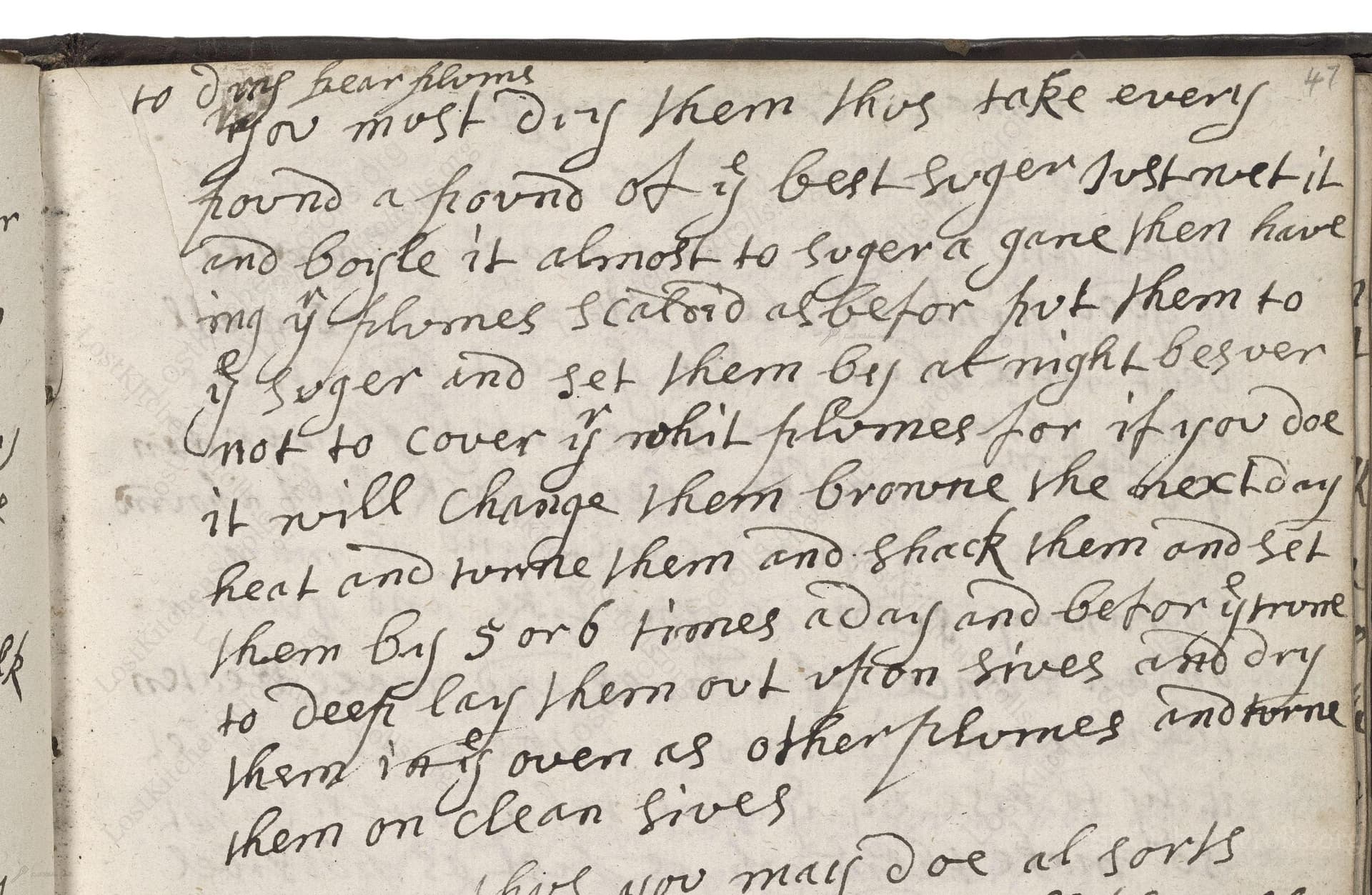To Dry Pear Ploms
From the treasured pages of Medicinal and cookery recipes by John King
Written by John King

To Dry Pear Ploms
"When you must dry them thus take every pound a pound of ye Best suger just wet it and boyle it almost to suger a gaine then haveing ye plomes scalded as befor put them to ye suger and set them by at night doe not to cover it while hot for if you doe it will change them browne the next day heat and wash them and shack them and set them by 5 or 6 times a day and befor you com to deep lay them out upon sives and dry them in ye oven as other plomes and turne them on clean sives"
Note on the Original Text
The recipe, like many of the early modern period, assumes the reader possesses a basic culinary literacy and practical experience. Instructions are direct, sometimes skipping steps or timings presumed obvious. Spelling and punctuation were less standardized (e.g. 'suger', 'boyle', 'shack'), and abbreviations like 'ye' for 'the' are common. Measuring is by weight (a pound per pound), but specific temperatures or times aren't given—judgment, technique, and the cook's senses mattered most.

Title
Medicinal and cookery recipes by John King (1675)
You can also click the book image above to peruse the original tome
Writer
John King
Era
1675
Publisher
Unknown
Background
A delightful journey into the kitchens of the 17th and early 18th centuries, this collection, attributed to John King, brims with time-honored recipes, culinary wisdom, and flavors that once graced historic tables.
Kindly made available by
Folger Shakespeare Library
This recipe is drawn from a handwritten household manuscript, attributed to John King and dating broadly from 1625 to 1725, a period when sugar was both precious and celebrated. Dried fruits like these were considered luxurious treats for the well-to-do, enjoyed through the winter and served for dessert or as part of elegant banquets. Recipes like this reveal the elaborate preservation skills that defined early modern kitchens, blending practicality with the exquisite sweetness of sugar syrups.

Originally, cooks would have used heavy copper pans or earthenware pots over an open fire or hearth for boiling the syrup. Fruit was drained using woven sieves or baskets and dried either in the gentle heat of a bread oven after baking, or in lofts and storerooms on reed mats or sives (shallow trays woven from wood or rush). A wooden spoon, skimmer or 'shaker' stirred and aerated the fruit during the heated stages. Today, you might use a heavy-bottomed saucepan, wire racks or modern baking sheets, and a low electric oven for drying.
Prep Time
30 mins
Cook Time
2 hrs
Servings
12
We've done our best to adapt this historical recipe for modern kitchens, but some details may still need refinement. We warmly welcome feedback from fellow cooks and culinary historians — your insights support the entire community!
Ingredients
- 2.2 lbs firm pears (or pear plums; substitute with firm plums if unavailable)
- 2.2 lbs white granulated sugar
- 7 tablespoons water (to wet the sugar)
Instructions
- To make dried pear plums, start by weighing your fruit and sugar: use 2.2 lbs of pears (substitute with firm plums or other fleshy fruit if pear plums are not available) and 2.2 lbs of white sugar.
- Gently wash and core the pears.
- Scald the fruit by placing it briefly in boiling water, then drain.
- Dissolve the sugar with just enough water (about 7 tablespoons) in a large pot.
- Boil the syrup until it thickens to nearly the soft-ball stage (240°F), just before it re-crystallizes.
- Add the scalded pears into the hot syrup.
- Leave the mixture uncovered to cool overnight—do not cover while hot, or the fruit will discolour.
- Reheat the next day, gently stirring.
- Repeat this process of heating and resting, turning or gently shaking the fruit in the syrup, 5 or 6 times throughout the day.
- Once the syrup has thickened and the pears are translucent, lift the fruit out, spreading them on wire racks or baking sheets lined with parchment.
- Dry the pears in a low oven (about 175°F) until they are no longer sticky but still soft, turning them occasionally.
- Store in airtight containers once completely cool.
Estimated Calories
250 per serving
Cooking Estimates
Preparing and cooking the pears will take a bit of time. First, you'll need time to clean, core, and briefly scald the pears. Then, making the syrup and simmering the fruit will take a few minutes each time you reheat. Most of the process is waiting for the fruit to rest in the syrup between reheatings. Drying the pears in the oven will take extra time, but most of this is hands-off. One serving has calories mainly from the pears and sugar.
As noted above, we have made our best effort to translate and adapt this historical recipe for modern kitchens, taking into account ingredients nowadays, cooking techniques, measurements, and so on. However, historical recipes often contain assumptions that require interpretation.
We'd love for anyone to help improve these adaptations. Community contributions are highly welcome. If you have suggestions, corrections, or cooking tips based on your experience with this recipe, please share them below.
Join the Discussion
Rate This Recipe
Dietary Preference
Main Ingredients

Den Bockfisch In Einer Fleisch Suppen Zu Kochen
This recipe hails from a German manuscript cookbook compiled in 1696, a time whe...

Die Grieß Nudlen Zumachen
This recipe comes from a rather mysterious manuscript cookbook, penned anonymous...

Ein Boudain
This recipe comes from an anonymous German-language manuscript cookbook from 169...

Ein Gesaltzen Citroni
This recipe, dating from 1696, comes from an extensive anonymous German cookbook...
Browse our complete collection of time-honored recipes



